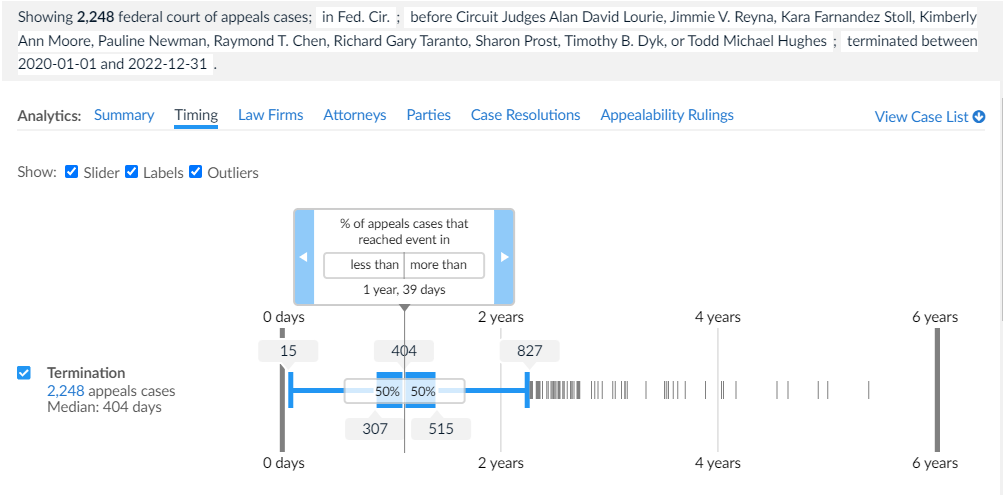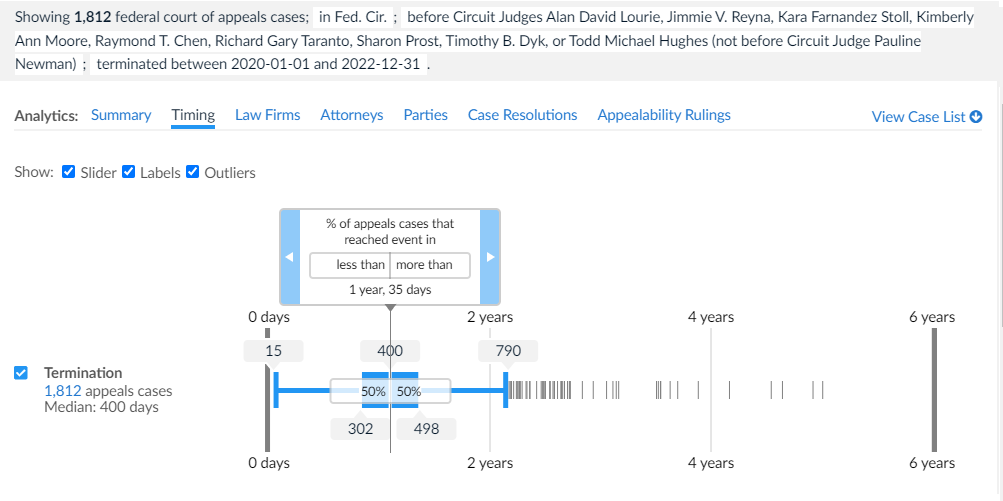On March 24, 2023, Kimberly Moore, chief judge of the Court of Appeals for the Federal Circuit, issued an order identifying a complaint under the Judicial Conduct and Disability Act, 28 U.S.C. §§ 351–364, against Pauline Newman, who has been a Federal Circuit judge since 1984. In the order, Judge Moore stated that she had found probable cause to believe that Judge Newman “has engaged in conduct prejudicial to the effective and expeditious administration of the business of the courts” and/or “is unable to discharge all the duties of office by reason of mental or physical disability.” According to Chief Judge Moore, “[j]udges and staff have reported extensive delays in the processing and resolution of cases” by Judge Newman despite a reduction in her workload in 2021 and 2022. A second order issued by Chief Judge Moore on April 13, 2023 concluded that “there is sufficient cause to believe that Judge Newman has failed to cooperate constituting additional misconduct.”
Lex Machina examined Federal Circuit data for the three-year period of January 1, 2020 to December 31, 2022, focusing on the 10 judges who were on active status during the entire time period. If a judge was a panelist on an appeal, then that case and its outcome are attributed to that judge; as a result, a case can be attributed to more than one judge. These panels may also include Judges Cunningham (appointed 2021) and Stark (appointed 2022), Judge O’Malley, who retired in March 2022, Judge Wallach, who went on senior status in May 2021, and Judges Bryson, Clevenger, Linn, Mayer, Plager, Schall, who are on senior status.
According to Lex Machina’s data, Judge Newman has been a panelist on the fewest number of cases terminated during the time period at 436 cases, and terminated cases on which she was a panelist have the longest median time to termination at 424 days. Median time to termination means that half of the cases terminated in less than the median number of days, and half of the cases terminated in more than the median number of days.
However, among all active judges, none of the judges who were panelists on appeals cases that were terminated during the time period had a median time to termination of less than a year.
| Judge | Number of Appeals Cases Terminated (1/1/20 – 12/31/22) |
Median Time to Termination in Days (1/1/20 – 12/31/22) |
| Chen | 520 | 388 |
| Dyk | 557 | 400 |
| Hughes | 496 | 415 |
| Lourie | 580 | 405 |
| Moore | 490 | 390 |
| Newman | 436 | 424 |
| Probst | 584 | 407 |
| Reyna | 577 | 422 |
| Stoll | 510 | 420 |
| Taranto | 583 | 401 |
In fact, for these 10 active judges, the median time to termination during the time period was 404 days for 2,248 appeals cases. As shown in the box plot below, the maximum number of days to termination for appeals cases during the time period, excluding outliers, was 827 days. A more detailed explanation of box plots and outliers as used in Lex Machina can be found here.

When Judge Newman was not a panelist, the median time to termination during the time period was 400 days for 1,812 appeals cases. The box plot below shows that the maximum number of days to termination for appeals cases during the time period, excluding outliers, was 790 days.

When the data is broken down by year, Judge Newman has the second fewest number of cases terminated in 2020 after Judge Hughes, and the fewest number of cases terminated in 2021 and 2022, although in 2022 she had 145 terminated cases compared to Chief Judge Moore’s 146 cases. For cases in which Judge Newman was a panelist, the median time to termination was the highest among her colleagues in 2022 at 441 days. Judge Prost had the second longest median time to termination at 429 days. In 2020 and 2021, Judge Newman did not have the longest median time to termination compared to her colleagues.
Lex Machina’s data indicates that even in individual years during the time period, the median time to termination for the active federal circuit judges is still more than a year (except for Chief Judge Moore, who in 2021 had a median time to termination of 364 days).
Analyzing the data can provide a more detailed, nuanced, and clear understanding of judicial performance. Lex Machina will continue to monitor the judge analytics of the parties involved as the inter-judicial conflict in the Federal Circuit continues to develop.